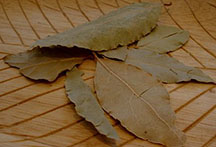
Other articles you might enjoy:
2. Nine Ways to Enjoy the Herb of the Year 2009: Bay Leaves
5. Bay Leaf Questions & Answers Page
Make the most of culinary herbs and spices.
All About Bay Leaves
by Sandra Bowens

The noble bay leaf has a history like no other herb. Legend and myth surrounded it even before the champions of the first Olympic Games, in 776 B.C, were crowned with garlands of the glossy green leaf.
Ancient mythology tells us that the sun god Apollo pursued the uninterested nymph Daphne. Apollo was relentless until the gods granted her mercy by turning her into a laurel, or bay, tree. The Greeks still refer to the tree as a Daphne.
Psalms 37:35 illustrates the esteem held for the mighty plant in Biblical times: "I have seen the wicked in great power, and spreading himself like a green bay tree."
Romans considered the bay tree a symbol of glory as well as protection from thunderstorms. Nero believed bay trees purified the air and Roman victors would wipe the blood from their swords with the leaves. In Shakespeare's time superstition held that when bay trees died, disaster was sure to follow.
The oil of bay berries was used for a wide range of medicinal purposes from a cure for pimples to "all griefs and pains proceeding from wind...," according to Culpepper's Complete Herbal from the 1600's.
Today the bay leaf is used around the world for culinary purposes. It is picked by hand from the evergreen Laurus nobilis or bay tree native to the Mediterranean. The trees will grow to heights of 60 feet with thick and shiny leaves. Thin layers of leaves are weighted down, to prevent curling, and dried in the shade. Drying in the sun causes them to turn brown and lose much of their essential oil. The flavor intensifies with proper drying but old leaves will fade quickly.
Bay leaves give off a delicate aromatic scent while offering a mildly bitter flavor. The bay leaf from California is stronger and oilier compared to those grown in other parts of the world. Turkey is a major supplier of imported bay leaves.
The most common form of bay leaf as an herb is the dried whole leaf. It may be crumbled into recipes or added whole. Crumble them well to avoid an unpleasant texture. Whole leaves should be removed before serving. Should you find fresh leaves, remember that they will be slightly more bitter than the dried version. You might shred a fresh leaf before adding to a recipe. Although rather difficult to find, ground bay leaves are convenient to use and excellent for creating your own spice blends.
Bay leaves are frequently used in soups, fish and meat dishes or marinades and vegetables. It is important to the classic bouquet garni. Bay leaves will always add more flavor to bean dishes and stews.
Basic Chicken Stock
Recipes for broth have a tendency to spark passionate debates among cooks. Alternate methods suggest using a whole chicken or roasting the bones before you boil them. Other methods will call for different vegetables and herbs. Consider this recipe an idea to build on.
Bones from a roasted chicken, meat removed
1 onion, peeled and quartered
3 celery stalks with leaves, cut into 3-inch lengths
2 large carrots with tops, if possible, cut into 3-inch lengths
1 small bunch parsley, optional
6 black peppercorns, optional
3 bay leaves
2 teaspoons dried thyme leaves OR 2 Tablespoons fresh
Place all ingredients into a large stockpot and add water to cover. Bring to a boil then reduce heat to a bare simmer. Simmer for 2 to 3 hours, skimming any scum that may rise.
Use tongs to transfer large pieces to a strainer placed over a large bowl. Strain remaining liquid into bowl.
If desired, chill stock and remove any fat that floats on top.
Also if desired, freeze pre-measured amounts of stock for later use. Try using a plastic quart container, freeze and then unmold into plastic bags. Or use an ice cube tray for small amounts.
DON'T salt the stock until you are using it in a recipe.
Here's one that's full of our favorite recipes because we wrote the book! It is also full of information, helpful hints and ideas for using herbs and spices in your kitchen.
This companion book to the hot-selling Barbecue! Bible adds flavor to the basic grilling methods.
Rosalind Creasy knows all about using food plants to round out your yard. She pioneered the idea 25 years ago. This updated edition includes 300 inspiring photographs.
Don't miss the latest from Louisiana's favorite son. Part history tour part cookbook, but it is all authentic to this Cajun and Creole crossroads.
There's more to salt than just the shaker, it is a life force. Follow along as it shapes the world.






